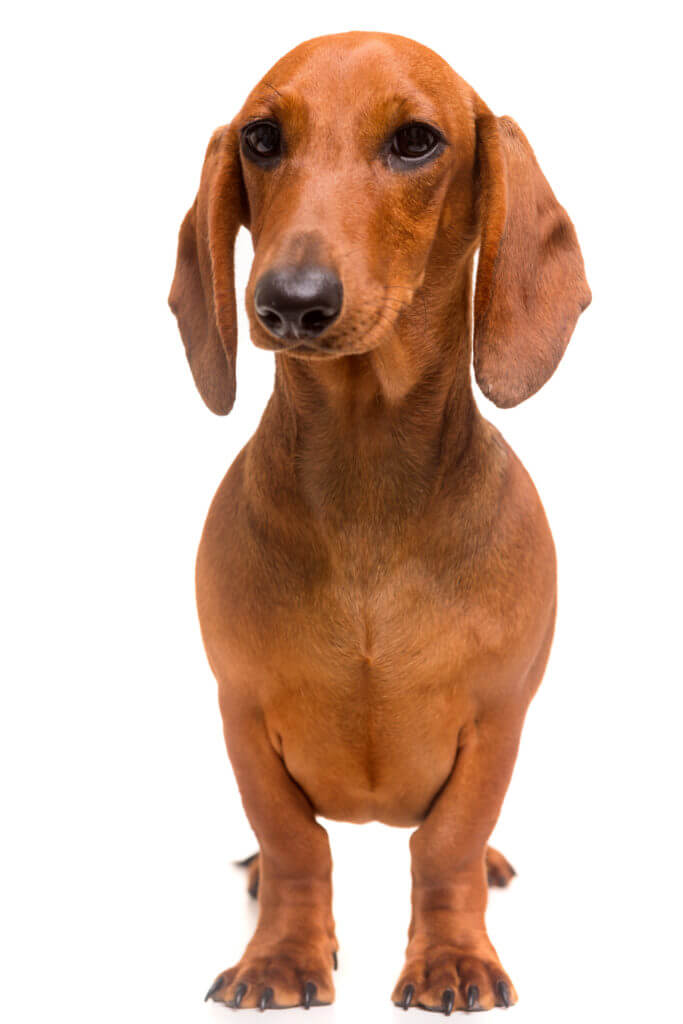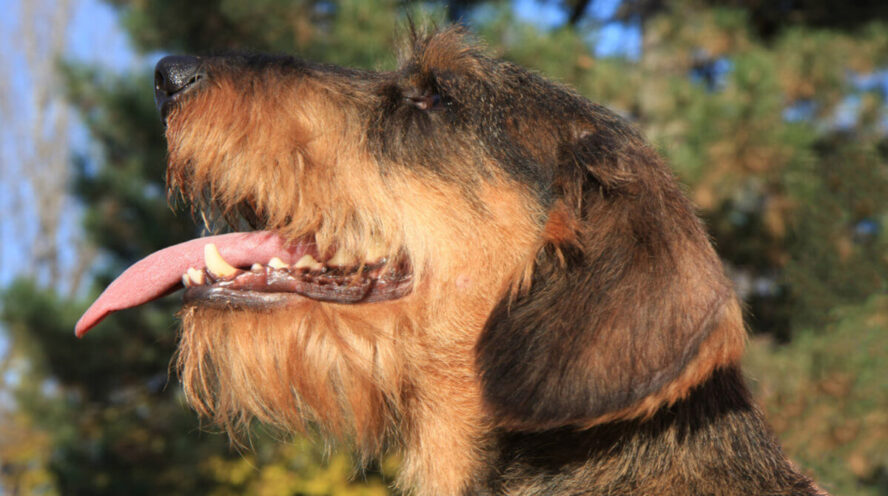Introduction to the dachshund breed
In Germany, Dachshund breed home country, it was known as the Teckel or Dackel. The name Dachshund which means badger dog was taken from the word Dash (European badger) and Hund from “hound dog.”
This incredible dog is very popular in many countries. Dachshund even earned its own museum, it is called Dackelmuseum, and located in Germany. It is the first and only dachshund museum in the world.
Dachshund breed comes in three varieties, the wire-haired, longhaired and the smooth (shorthaired).
In Germany, the birthplace of Dachshunds, they are identified as Kaninchenteckel, Miniature or Standard.
This separation is based on their chest measurement taken at an early age of fifteen months.
Amongst the hounds, the Dachshund may seem the smallest. But in spirit, they are undoubtedly ones of the greatest.

The journalist H. L. Mencken, once jokingly described the dachshund as a “half a dog high and a dog and a half long.”
Do not get deceived by the small size of the dachshund; it is more than strong enough to take down a badger.
Dachshund breed purpose
Dachshunds are scent hound dog breed that were specifically bred to hunt badgers as well as other tunnelling animals like rabbits, and foxes.
Dachshund breed descends from the hunting dogs that courageously follow their prey into underground tunnels.
This passionate feature of the dachshund to track down their prey leads the breed to the point of stubbornness and as such, can be a bit aggressive with other dogs.
Dachshunds are passionate diggers, long-bodied short-legged dogs with the courage and determination to take down badgers from their dens.
If you want to find out more, please read our article about What are dachshunds bred for.
Dachshund breed origins

The very first Dachshunds possessed a smooth coat which could be just about any colour.
The longhaired Dachshund, which is widely used for hunting water-loving prey like the otters, had been developed by way of crosses with spaniels.
The youngest of the variations, wire-haired dachshund obtained recognition in 1890. Its rough coat protects it from thorny scrub while he goes after his target.
It was in 1870 Dachshund first came into the United States, with the sole purpose to hunt down rabbits. In 1885, the American Kennel Club registered its first Dachshund, and ten years later, the Dachshund Club of America was created.
Dachshund breed was valued for the powerful scenting potential, uniqueness in size, and willpower to drill down as well as boldness in the midst of a powerful foe.
Breeds that most likely played a significant part in the evolution of the dachshund were the Schweisshund (a kind of Bloodhound), Basset Hounds, Beagles and a pointer-type dog known as Dachsbracke.
Dachshunds are sometimes nicknamed wiener or sausage dogs because of their long and narrow build.
In fact, there are many nicknames for these extraordinary dogs, they are all highlighted in our article “Dachshund Nicknames”.
As well as that, we have created a guide with 250+ Unique Dachshund Name Ideas, so you can pick a perfect name for your new puppy.

Dachshund breed recognition after World War I
Owing to its German heritage, the Dachshund breed recognition started to take a fall at the time of World War I.
Following the war, it took several numbers of years before the breed could begin to gain back recognition again.
As soon as dachshunds popularity comes back, the World War II, for a second time with the Germans in the role of foes, was able to hinder the Dachshund’s soar to its present position as being one of America’s most loved dogs.
In the world today, the Dachshund is rated as number eight among the dog breeds certified by the AKC.
Dachshund breed varieties
Smooth-haired (shorthaired) dachshund

Undoubtedly, the smooth-haired dachshund happens to be the most popular variety of dachshunds in the United States.
It has short and shiny coat which needs a little amount of grooming from time to time. During winter, in case you live in areas prone to cold weather, you will need a sweater for your shorthaired weiner.
Known shorthaired dachshund colours include black and cream, blue and tan, black and tan, Isabella (fawn) and tan, chocolate and tan, red, cream.
Smooth dachshunds also sometimes have patterns on their coats, such as sable, piebald, brindle and dapple (mottled coat pattern). There is also a double dapple pattern, which is, however, associated with various genetic health problems in dachshunds.
Longhaired dachshund

The longhaired dachshunds have slightly wavy and sleek hair and mostly can have just the same colours as the shorthaired dachshunds.
When it comes to temperament, the longhaired sausage dogs are definitely more laid-back compared to the smooth-haired or wire-haired dachshunds.
Areas around their ears and elbows should be brushed daily in order to prevent mats from forming.
The best way to help your dachshund live longer?
Watch our video to find out!
Wire-haired dachshund

The wire-haired dachshunds, just like the shorthaired doxies, are often mischievous. They have a wiry, thick, short hair, beard and rough coats with bushy eyebrows.
Therefore, during winter, unlike the shorthaired dachshunds, the wire-haired weiners do not need a sweater.
Also, you will need to brush the wire-haired dachshund regularly to prevent mats from forming.
The wire-haired doxies can have the same coat colour as the smooth ones.
However, the most common wire-haired dachshund colour in the United States are black and tan, wild boar (a mixture of black, brown, and grey), as well as various shades of red.
If you want to find out more about the dachshunds sizes, colours and patterns read our article about dachshund sizes and varieties.
Dachshund breed personality
The first responsibility a dachshund owner has to take on is an in-depth understanding of its psyche and behavioural pattern.
There’s an African proverb that addresses some petite people as “small but mighty,” and that’s the perfect description of the dachshund breed.
They might be small, but they are daring, adventurous and love exploring new territories, scents, and people.
Here are few of dachshund’s main personalities traits that every owner should know before getting dachshund as a companion:
✔️ Intelligent
One thing to love about this cuties is their intelligence.
Dachshunds are undoubtedly brainy dogs – this intelligence makes them require training, lots of activities and exercises.
✔️ Independent
Sausage dogs are also independent; they can figure out a few things on their own compared to other breeds of dogs who seem to be totally dependent on their owners.
✔️ Very Loyal
These mini-champs are loyalists; once they feel secure, accepted and loved into a family, they will watch over the house, they will protect the children, and they will be on the lookout for any disruption.
✔️Aggressive
Apparently, sausage dogs can be aggressive toward strangers and strange dogs or sudden changes in the house. We wrote a separate article about aggressive behaviour in dachshunds.
✔️Loud Barkers
Dachshunds were raised as hunting dogs, so forgive the barking – old habits die hard.
✔️Playful
Weiner dogs are also very playful; always full of life and energised, they can make play out of anything, at any time and anywhere.
✔️ Heavy eaters
Above all, dachshunds like to eat. Their desire for food is on the high side, and may correctly be described as ravenous.
In other words, when they are given the chance, dachshunds can eat to the extent they get sick.
Dachshunds that are obese are more likely to get exposed to musculoskeletal issues (Intervertebral Disc Disease).
In order to avert obesity as well as a case of garbage gut, it is essential that you measure the dachshund food.
That is to say, you should treat your doxie on a standard ration. Also, do not tempt it by disposing of food ruminants in the trash or in places where it can reach them.
You are welcome to read our detailed articles concerning your dachshund weight management:

All the traits mentioned above make up you dachshund’s habits, lifestyle choices, open-mindedness towards training and new environments, sensitivities, and care.
If you are considering getting a dachshund, these traits, without saying, become one of the main factors you should think about when bringing a puppy home.
Additionally, you can read our article “Are dachshunds good family pets” to help you with your decision.
Overall, bringing a dachshund into your life will change it quite drastically. (And I promise in a positive way).
In this article, we shared just a few major things to be aware of before making this life-changing decision.



Comments
Can you help me find a teacup Dachshund
I also am trying to find a teacup dachshund for my mother. Her dachshund passed and after 4 years she is ready for another dog.
Love sausag